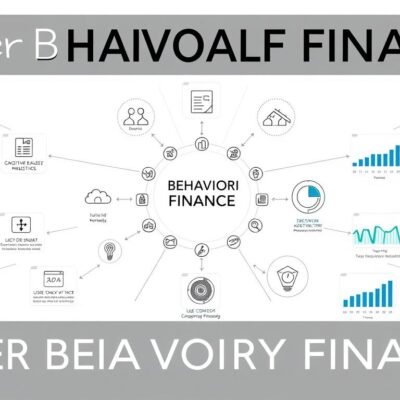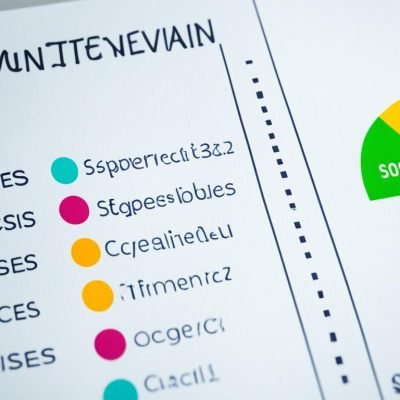Many investors forget about taxes when planning their portfolios. But taxes can cut down on returns a lot. The IRS taxes investment income like regular wages. But, smart strategies can reduce this impact a lot.
Choosing the right accounts and holding periods is key. Long-term holdings get lower tax rates, while short-term gains face higher taxes. Tax-efficient strategies focus on timing and account types to lower taxes1.
Key Takeaways
- RMD ages now start at 73 for those born after 1950, per IRS updates2.
- Long-term capital gains face 15%-20% rates, while short-term gains use income tax brackets1.
- Wash sale rules block tax losses if similar assets are bought within 30 days2.
- Estate tax exemptions revert to $5 million in 2026, adjusted for inflation2.
- Tax-deferred accounts like IRAs delay taxes until withdrawals1.
Understanding Tax-Efficient Investment Options
Smart investors look for tax-efficient options to boost their returns. These choices help keep more money in your portfolio by reducing taxes. This way, your profits can grow without being eaten up by taxes.
What Are Tax-Efficient Investments?
Tax-efficient assets include mutual funds, ETFs, and retirement accounts. They aim to lower your tax bill. For example, index funds tend to have fewer capital gains than actively traded ones.
Morningstar’s Tax Cost Ratio helps compare funds by showing how much taxes cut into returns3. Tax-advantaged accounts like Roth IRAs let your money grow tax-free if you follow the rules.
The Importance of Tax Efficiency
Over time, saving on taxes can really add up. Investors in higher tax brackets benefit a lot from long-term capital gains taxed at 0%, 15%, or 20%4. For instance, holding onto stocks for years can save thousands in taxes compared to frequent trading.
Using tax-efficient methods also helps protect against market ups and downs. Deferring gains through buy-and-hold strategies can lower immediate tax liabilities4.
Key benefits include: lower annual tax bills, preserved compounding, and flexibility in retirement planning. Even small improvements in tax efficiency can make a big difference over decades. With smart choices, $100,000 could grow to $200,000+ or more. The right tax-efficient investment options make your money work harder for you.
Tax-Advantaged Accounts Explained
To lower your taxes, it’s key to know about special accounts. IRAs, 401(k)s, and HSAs are great for saving. They help based on your income, age, and goals.
Individual Retirement Accounts (IRAs)
- Traditional IRAs let you contribute before taxes, which lowers your income now. But, you’ll pay taxes on withdrawals later5.
- Roth IRAs mean you pay taxes now. But, you get tax-free money in retirement if you wait five years after age 59½6.
- In 2024, you can contribute up to $7,000, or $8,000 if you’re 50+. But, income limits might affect Roth IRA access6.
401(k) Plans
401(k)s from your employer let you save up to $23,500 in 2024. If you’re 50+, you can add $7,500 more6. They offer:
- Contributions before taxes, which lowers your income now5.
- Roth 401(k) options mean you contribute after taxes. Then, you get tax-free money in retirement6.
- There’s a cap on how much you and your employer can contribute together, at $70,000 a year6.
Health Savings Accounts (HSAs)
HSAs give you a triple tax benefit. Contributions are deductible, growth is tax-free, and withdrawals for medical costs are tax-free6. You need a high-deductible health plan to qualify. In 2024, you can contribute up to $3,300 if you’re single, or $6,750 if you’re a family5.
These accounts are key for saving taxes. But, you must follow IRS rules. Always check current limits and talk to a tax advisor for advice.
Real Estate Investment for Tax Benefits
Real estate is a top tax-efficient investment option because of its many deductions and deferrals. When managed well, properties can reduce taxable income. This lets owners save money through smart planning7
Investors can lower their taxes by deducting mortgage interest, property taxes, and repairs. Depreciation lets them deduct a part of the property’s value each year. For example, a $300,000 rental property with $40k land value gets a $10,909 yearly depreciation deduction7. At a 25% tax rate, this saves $3,272 annually8.
A 1031 exchange allows investors to defer capital gains tax by exchanging real property held for business or investment purposes for similar real property.
Key rules for 1031 exchanges include:
- Identify replacement property within 45 days of sale
- Complete the exchange within 180 days
- Use a qualified intermediary to handle funds
Opportunity Zones offer extra benefits. Investors can delay gains by investing in these areas within 180 days of a sale. Holding assets for 10 years makes gains permanent. There are over 8,700 Opportunity Zones across the country7, offering 10% gain exclusion after 5 years and 5% more after 77.
Real estate’s tax benefits make it key for building long-term wealth. It’s wise to talk to a tax advisor to understand the rules and save more. Proper planning ensures you follow IRS rules and get the most benefits.
Utilizing Tax-Free Investment Vehicles
Investments like municipal bonds and Roth IRAs can cut or wipe out taxes on earnings. These strategies help grow your money over time without losing it to taxes. They are key to a smart investment plan.
Municipal Bonds
Municipal bonds are issued by local governments. They offer interest that’s not taxed by the federal government. If you live in the state where the bond was issued, you might also avoid state and local taxes.
Investors use a formula to compare these bonds’ yields. This helps them see how much they’ll make based on their tax rate9.
- General obligation bonds fund public projects like schools.
- Revenue bonds finance specific assets such as toll roads or hospitals.

Roth IRAs
Roth IRAs let you contribute after taxes. But, the money grows tax-free. When you withdraw it after age 59½, it’s tax-free too, making them great for retirement9.
High earners can convert traditional IRA funds to Roth accounts. This is called a backdoor conversion. Even if you make too much to contribute directly, you can still do this. Roth IRAs might save you more in taxes over time, depending on your future income9.
Deciding between tax-free growth and tax-deferred options depends on your current and future income. These investments are essential for a tax-wise portfolio.
Capital Gains Tax: What You Need to Know
Capital gains taxes depend on how long you hold onto assets. To save on taxes, it’s smart to sell at the right time to get lower rates. Also, planning your investments wisely can help you avoid higher taxes10.
Short-Term vs. Long-Term Capital Gains
Short-term gains are taxed like regular income if you sell within a year. Long-term gains have lower rates of 0%, 15%, or 20%. For 2024, if you’re single and earn less than $47,025, you pay 0%. But, if you make more than $518,900, you face higher rates10.
Strategies to Minimize Capital Gains Taxes
- Hold assets for more than a year to get lower rates10.
- Use tax-loss harvesting to offset up to $3,000 of income each year10.
- Avoid wash sales by not buying back an asset within 30 days of selling it10.
- Gift appreciated assets to family in lower tax brackets or donate to charities to reduce taxable gains10.
- Align sales with years of lower income to reduce overall tax liability10.
Placing income-generating assets in tax-deferred accounts can increase your after-tax returns. This is part of tax-aware investment planning10.
Tax Efficiency in Mutual Funds
Mutual funds have different tax impacts. Tax-efficient funds aim to keep more of your earnings by reducing taxes. Morningstar’s tax cost ratio shows how much taxes cut into your returns6. Funds with lower ratios tend to have less tax drag.
The Role of Fund Structure
Funds pass dividends and capital gains to shareholders each year. High turnover funds, which trade assets often, lead to more taxes. Check the fund’s annual turnover rate in its disclosures. Big funds might spread costs but aren’t always tax-friendly6.
Look for low-turnover funds like index funds for better tax results.
Tax-Loss Harvesting Techniques
Selling mutual funds at a loss can lower your tax bill. You can use up to $3,000 of losses to offset taxable income each year6. But, avoid the IRS wash sale rule: don’t buy the same fund within 30 days of selling.
Replace it with a similar fund or ETF to keep your portfolio balanced.
For example, selling a fund at a $5,000 loss lets you claim $3,000 now and carry over $2,000. Keep track of your trades to avoid IRS issues. Tax-efficient financial planning uses these strategies to maximize gains while following IRS rules6.
ETFs: A Tax-Friendly Alternative
Exchange-Traded Funds (ETFs) are smarter for saving taxes than traditional mutual funds. They have a structure that reduces taxable events. This makes them a great choice for tax-efficient funds and tax-efficient assets in taxable accounts.
Advantages of ETFs Over Mutual Funds
ETFs avoid frequent trading by using in-kind transfers. This reduces capital gains distributions. Mutual funds, on the other hand, often have higher tax costs.
For example, large-blend mutual funds had a median tax-cost ratio of 1.61% over a decade. This can eat into your returns11. ETFs distribute fewer taxable gains, keeping more of your profits. But, bond ETFs need caution as some may have tax burdens that offset returns11.
How to Choose Tax-Efficient ETFs
Look for ETFs with low turnover rates and minimal distributions. Funds like the iShares Core MSCI Total International Stock ETF have a 3.2% dividend yield. They often outperform mutual funds in tax efficiency11.
Consider these key factors:
- Turnover rate: Lower rates mean fewer taxable trades
- Distribution history: Check past capital gains payouts
- Asset class: Equity ETFs generally outperform bonds in tax savings
- Track record: Compare tax-cost ratios versus mutual funds
Even tax-managed funds like Vanguard Tax-Managed Capital Appreciation have competitive ratios. But ETFs still stand out in liquidity and cost efficiency11. Always balance tax savings with other criteria like fees and diversification goals.
Tax Implications for Dividends
Dividends add income to investments but come with tax rules that demand careful planning. Qualified dividends get a break, taxed at 0%, 15%, or 20% based on income. On the other hand, ordinary dividends face higher rates up to 37%12. The main difference is in holding periods and the type of company issuing the dividend.

To get the lower rates, stocks must be held for more than 61 days. Ordinary dividends, like those from REITs or foreign firms not meeting IRS criteria, don’t get this benefit13. High earners also face a 3.8% Net Investment Income Tax (NIIT) on top of regular rates13. Here’s how to optimize:
- Place qualified dividend stocks in taxable accounts to maximize their preferential rates.
- Use tax-advantaged accounts like Roth IRAs for non-qualified dividends to defer or avoid taxes.
- Avoid selling shares too soon—holding periods ensure qualified status.
requires timing sales to avoid wash sales (trading similar stocks within 30 days of a sale) to preserve tax losses13. High-income investors should also track NIIT thresholds to stay under the 3.8% surtax trigger13. By aligning dividend strategies with holding periods and account types, investors can boost after-tax returns through .
Tax Considerations for International Investments
Investing globally means you need to think about taxes to avoid paying twice. The Foreign Tax Credit (FTC) helps U.S. investors by letting them offset taxes paid in other countries. This credit can only be used up to the amount of U.S. taxes owed14. If you paid more than $300 in foreign taxes (or $600 if filing jointly), you must use Form 1116 to claim your credits15
Foreign Tax Credits Simplified:
- Foreign taxes paid reduce U.S. tax owed dollar-for-dollar
- Unused credits can carry forward up to 10 years
- Form 1116 required for credits exceeding automatic thresholds
Understanding Foreign Tax Credits
The FTC stops you from being taxed twice on things like dividends, interest, and capital gains. For instance, taxes on Italian stock sales can be 26%, but U.S. taxpayers can get credits for this15. Also, if you have foreign mutual funds, watch out for Passive Foreign Investment Companies (PFICs). If 75% or more of the income is passive, you could face higher taxes14.
Implications of Tax Treaties
International treaties can lower withholding taxes. For example, the U.S.-Canada treaty lowers stock dividend withholding to 5% from 15%16. In Europe, France has a 30% capital gains tax, while the U.S. has a 20% long-term rate15. To comply, you should:
- File FinCEN Form 114 if you have more than $10,000 in offshore assets15
- Report foreign accounts with more than $50,000 on Form 893814
- Keep track of PFIC holdings to avoid a 35% default tax rate16
To invest wisely, stay updated on treaty changes and how to structure your foreign holdings. Getting help from a professional can make a big difference in managing your taxes and investments.
Sustainable Investing and Tax Efficiency
Combining eco-friendly goals with tax-efficient investment options
Green municipal bonds fund eco-friendly projects and offer tax-free income. But, their interest might be taxed under the Alternative Minimum Tax1718. Opportunity zone funds let investors delay taxes on gains from low-income areas. Community development financial institutions (CDFIs) get tax credits for funding green projects17.
Green Investments That Save Taxes
- Green municipal bonds: Tax-free income for qualifying projects17.
- Opportunity Zone Funds: Defer capital gains taxes for investments in underserved areas17.
- Renewable Energy Tax Credits: The Investment Tax Credit (ITC) and Production Tax Credit (PTC) reduce costs for solar/wind projects, with phase-outs tied to federal guidelines17.
Tax Incentives for Renewable Energy
Investors in solar or wind projects can claim the ITC. It covers up to 30% of costs until 203217. The PTC gives credits for each kilowatt-hour of energy produced. These incentives lower costs and encourage tax-advantaged investing in clean energy17.
It’s important to do your homework. Tax laws change often, and some incentives come with risks like AMT exposure18. Morgan Stanley suggests talking to tax advisors before investing17.
Financial Advisors and Tax Planning
Getting help from a pro is key for matching tax-efficient financial planning with your goals. They look at how taxes affect your retirement accounts, where to put your assets, and estate plans. This helps you keep more of your money.
Importance of Expert Guidance
“Tax-efficient portfolios can boost after-tax returns by 1-2% each year”19, research shows. Advisors check out chances like Roth IRA conversions19 and tax-loss harvesting all year20. They also look at ETFs like Vanguard’s Tax-Aware Series19.
They also explain trust setups, pointing out that big firms like Morgan Stanley need a third party for these20.
How to Choose the Right Advisor
Look for advisors with:
- Certifications: CPA, PFS, or CFP®
- Fiduciary duty and fee transparency
- Experience with multi-generational tax planning
Ask about their approach to smart tax moves like timing capital gains20 or setting up charitable gifts. Good advisors can cut tax costs by 0.5-1% yearly19, helping your wealth grow over time.
They also tackle Social Security timing, bond risks, and state taxes. A 15% boost in client loyalty19 shows tax planning’s worth in managing wealth. Make sure they work with tax pros to avoid mistakes.
Future Trends in Tax-Efficient Investing
Legislative changes and new investment tools are changing the financial world. It’s crucial to stay updated on tax-aware investment planning. Tax-efficient strategies need to keep up with tax law changes and new opportunities.
Legislative Changes to Watch
The Tax Cuts and Jobs Act (TCJA) is set to expire in 2026. This could increase top marginal rates to 39.6% for regular income. It might also eliminate deductions, affecting capital gains rates for the wealthy21.
Investors should keep an eye on SALT deduction rules. The $10,000 cap will stay unless Congress changes it21. The SECURE Act is raising the RMD age to 73 by 2023, impacting retirement withdrawals22.
Emerging Investment Vehicles and Their Tax Implications
Direct indexing platforms offer tailored tax-loss harvesting. This allows for personalized portfolio adjustments23. These strategies could grow assets to over $800 billion by 2026, with tax alpha gains averaging 1.08% annually23.
Tools like BNY Mellon’s S&P 500®-tracking portfolios make index replication more tax-efficient23. Cryptocurrency and tokenized securities bring new tax challenges, requiring advanced tracking systems.
Investors are using tax-aware planning to stay ahead. They’re preparing for 2026 tax code changes and exploring qualified opportunity zones. Regular reviews with advisors and using technology for tax-loss harvesting are key to long-term growth2223.










